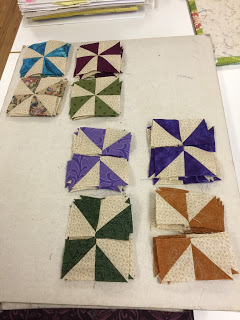


This tutorial at WeAllSew.com from Fat Quarter Shop, features the woodland themes of Big Sky from Moda Fabrics in a fast-to-finish ruffled pillow.
To honor July 4th, we found what we thought was the most patriotic quilt at the Paducah Quilt Show this year. In the Group Quilt category we found this. It is by the Slicing Seven group from La Mesa, California. Birth of the Red, White, and Blue is 60" x 40" and is based on Birth of the Flag, a painting by Henry Mosler. We love how the sections done by different people fit so well together.
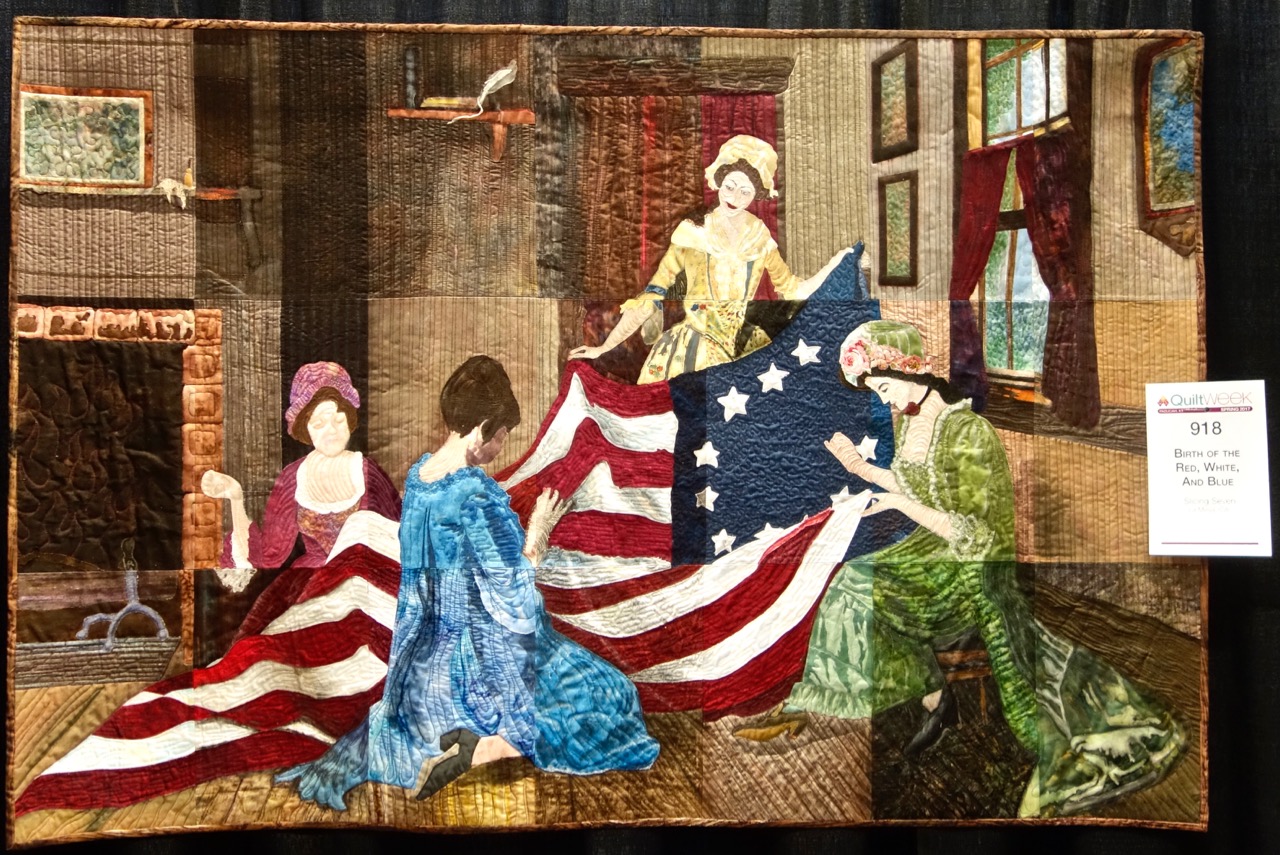
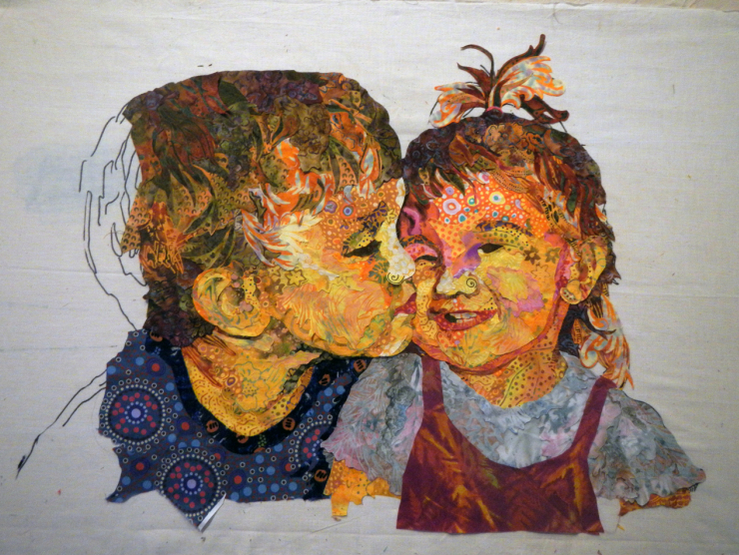
Why is it that some quilts never leave the depths of the WIP (Work In Progress) pile? Did you lose interest, or did the fabrics and color choices just not play together well? For the next several weeks we will take a brief pause from our focus on the fundamentals of color, to look at how and what fabric choices you make can result in a flat or less dynamic quilt.
Scale, value and pattern can make a huge difference when it comes to selecting fabrics for your quilt project. It's one thing to understand the principles of the terms, but another matter when it comes to actually putting a fabric group together.
Let's look at Kissin' Cousins by Susan Carlson. This WIP illustrates the wide array of fabrics Susan has used in her collage work to create depth and realism on the faces of the two children. In the detail of the girl's face below, you will notice the masterful way she combined fabrics with prints of different sizes, themes and colors to give depth and interest. Susan's skillful use with what many would consider fabrics that absolutely would not play well together, in fact actually do make for a very harmonious grouping.

Another master when it comes to gathering a very diverse fabric collection for quilt projects is Karen K. Stone (Show 1611). Two examples that showcase the vast array of fabrics, patterns, scale and size, she customarily uses in her work are Lillith and Clam Session.

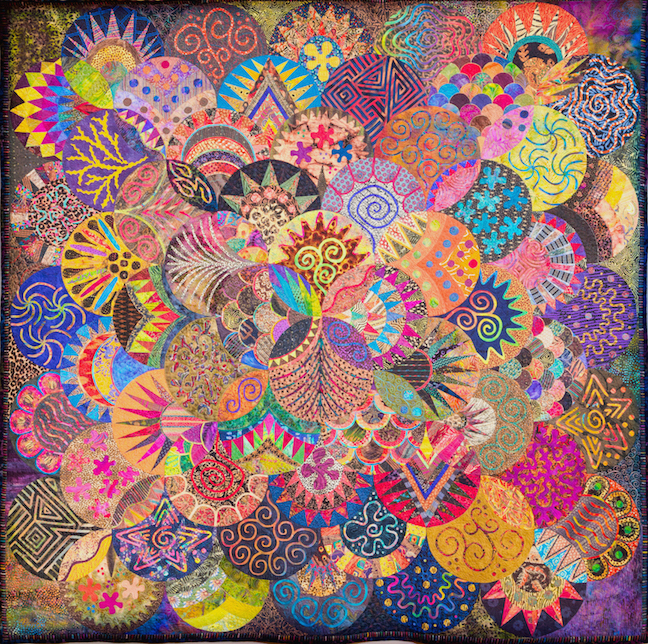


But where does one start when it comes to deciding on what fabrics to cull or purchase? As a quilter, your local quilt shop is a great resource. Most shops offer pre-cut designer fabric collection bundles, such as charm squares ( 5" x 5"), jelly rolls ( 2 1/2" x 45"), layer cakes (10" x 10") and fat quarter bundles (9" x 22"). These groupings, usually based on a theme, offer a nice array of fabric prints in one complete collection; or let a favorite fabric be the inspiration for your grouping. And don't forget to check out those colored dots along the selvedge of your inspirational fabric, as they are very useful for matching color.
What if the current collections at your local quilt shop don't make you swoon, or you want to build a fabric group from your own stash? Here are a few basic tips to keep you on track.
Scale/size - Include a variety of small, medium, and large prints. By including a mix of the three, your work will have more depth and variety.
Value - Include a wide range of light, medium and dark to avoid your work from reading flat. Are you not sure about relying on your instincts? Use the Ultimate 3-in-1 Color Tool to help solve the mystery. Each of the twenty-four pages illustrates the pure color, tints, shades and tones of a family, allowing you the opportunity to select from a wide array of fabrics to make a quilt more interesting.
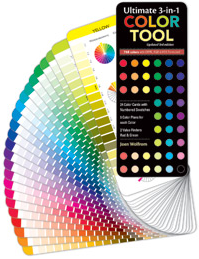

In Show 1307 Alex Anderson shares her method for gathering fabrics when beginning a scrap quilt. From selecting a wide range of fabrics, to the role value plays within a star block, diversity of fabric choice can make a huge difference.

In Show 1413 Leni Levenson Wiener shows what a difference 'zingers' make when selecting fabrics for her trees.
Becky Goldsmith (Shows 611 &1704) is an award-winning quilter who teaches both nationally and internationally, says that 'quilters paint with fabric.' And as such the need to understanding how fabric works can mean the difference between a quilt project that is forever doomed to the UFO dungeon or a loved and completed piece.
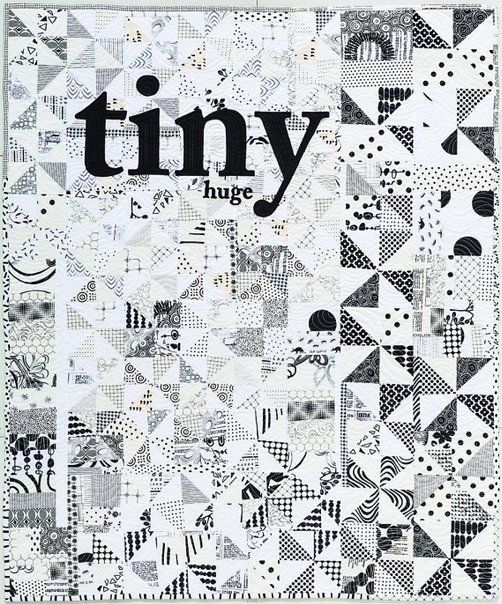
by Becky Goldsmith (Shows 611 & 1704)
Fabric falls into two broad categories: predictable and unpredictable. Predictable fabrics are not ‘better’ than unpredictable fabrics—they just behave differently. When you can see at a glance which category a fabric falls into, it makes choosing fabric for a quilt much easier.
A predictable fabric can be cut into big or small pieces and it will the look the same everywhere it shows up in the quilt. In pieced quilts, that is a very good thing.
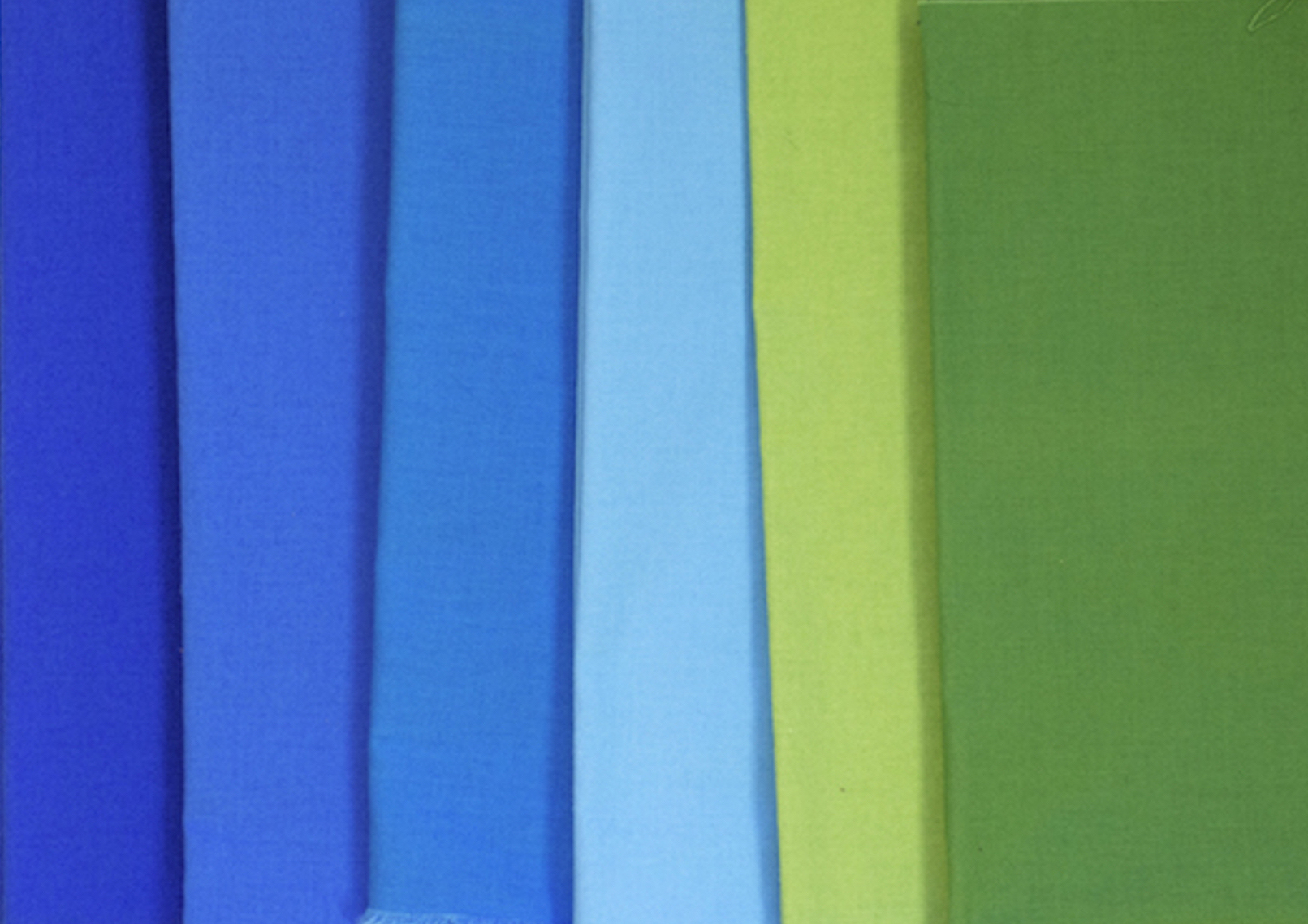
Solids
Solids are the most predictable fabric.
No matter how you cut them, they always look the same.
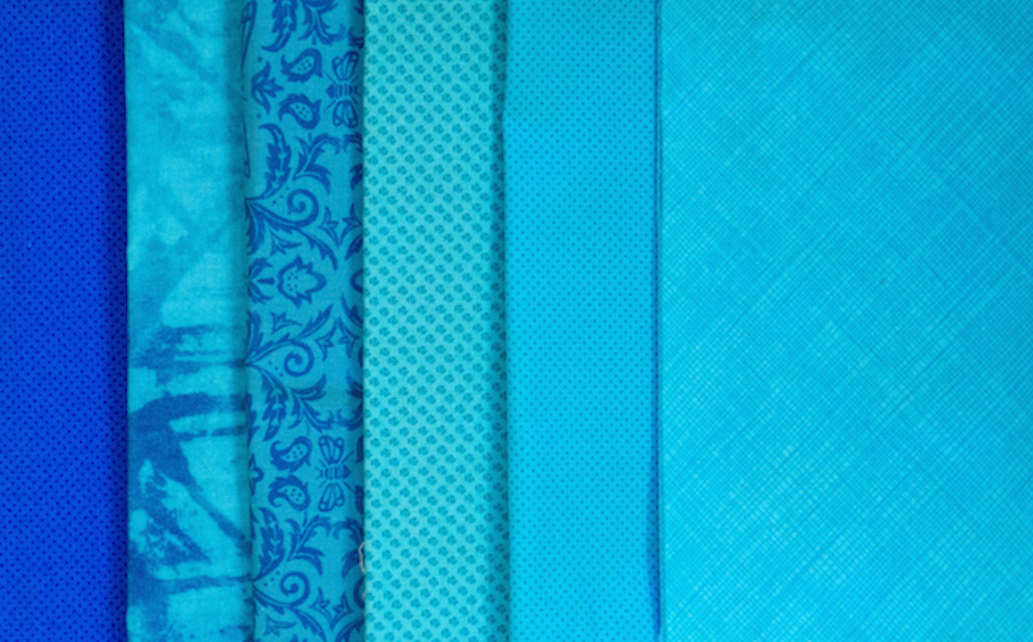
Tone-On-Tones
Tone-on-tone fabrics usually read as a solid at a distance. Tone-on-tone prints can be quiet or visually active. If the values in the print are close together the fabric will read more as a solid and be ‘quieter’. The more contrast in the print, the more noticeable and visually active the fabric becomes.
Tone-on-tone prints come in all sizes: small-, medium-, and large-scale.
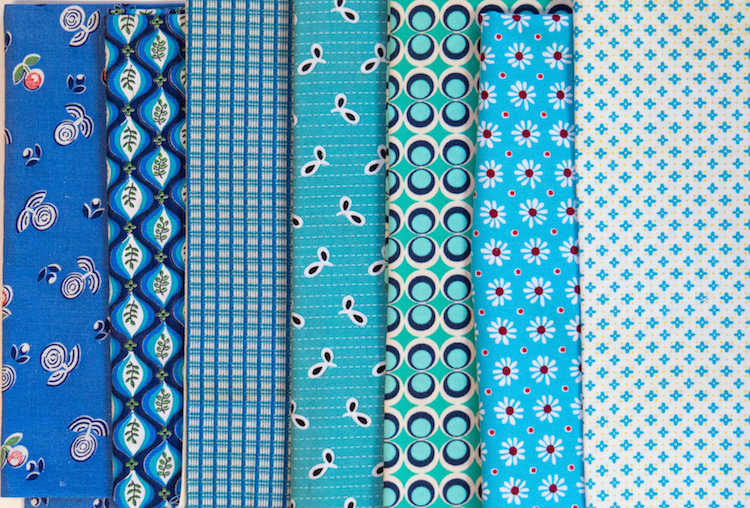
Small Prints
The motifs and colors in small prints are near enough to each other that when cut into small pieces, they look the same no matter what part of the fabric they are cut from.

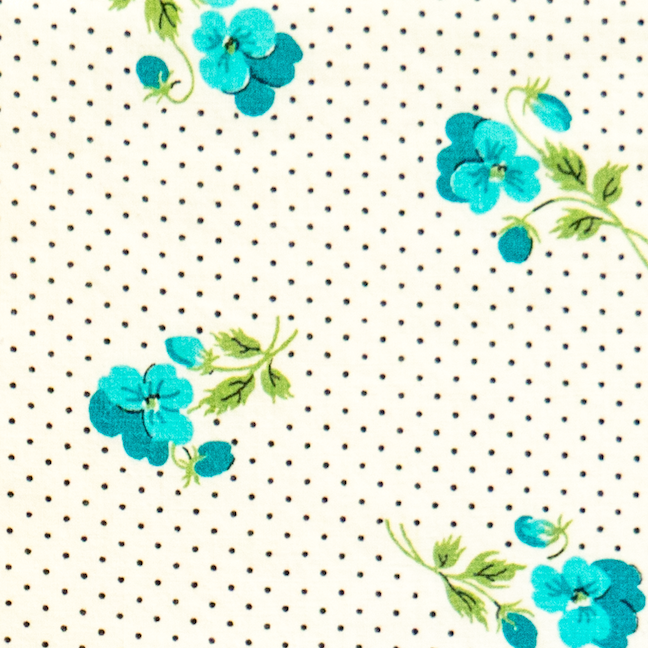
Some small prints have motifs that are more widely spaced. The designs in the print won’t be exactly the same in the pieces you cut from the fabric, but the print will retain its character. This antique fabric feels open and airy in both large and small sizes.

Medium Prints
Medium prints have obviously bigger motifs than those you find in small prints, but many are still predictable. Look for designs where the colors in the print are mixed together well across the face of the fabric.
Unpredictable fabrics are ones where the motifs are often big and widely spaced. When you cut small pieces from unpredictable fabrics, you can’t predict which color will end up where and that can play havoc in repeating blocks.
Big Prints
Most quilters shy away from big prints because they look hard to use, but I encourage you to give them a try. Big prints have an expansive feeling that can add motion and depth to your quilt.

Big Prints
Most quilters shy away from big prints because they look hard to use, but I encourage you to give them a try. Big prints have an expansive feeling that can add motion and depth to your quilt.
When you cut big prints into small pieces, the design is fragmented.
If you bought the print because you liked it as a whole, this can be disconcerting.
These squares, from the big print above far left, are a good example of that.
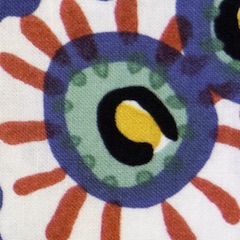
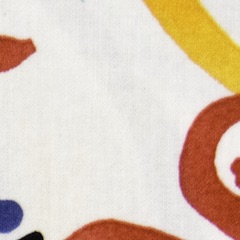

Sometimes colors are segregated into discrete areas. For example, if you cut 2” squares from the rainbow dot fabric (designed by Greta Lynn) you will end up with squares that are blue, or red, or yellow, etc. If your pattern calls for mostly blue squares, the others are not going to fit into your design.
That doesn’t mean that these are not good and useful fabrics! One simple example is to combine one of these prints with one solid or near-solid contrasting fabric. Imagine 9-patches made with the rainbow dot against white. You would have a happy and colorful quilt from just these two fabrics.
Predictable Big Prints
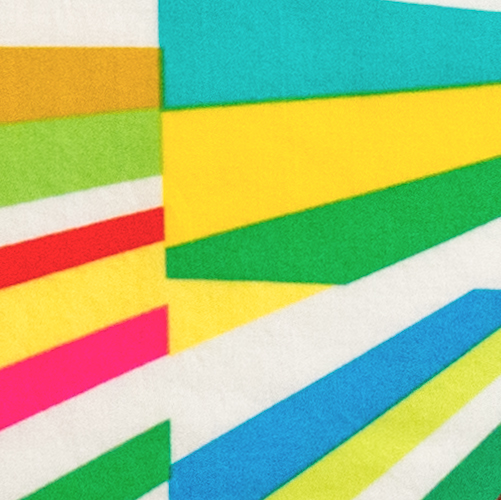

Big prints are not always unpredictable and they are well worth using.
This wonderful fabric (on the left) is based on a pieced quilt, Tara’s Fireworks Quilt (fabric from Michael Miller). This cut is roughly fat-quarter-size.
You could use it as is, but it is easier to use in small pieces than you might think. The overall flavor of the print remains the same.

Whether a fabric is predictable or unpredictable, always remember that the color, value, and scale of any print can only be measured against the fabrics they are paired with. A medium-scale print will look big when compared with solids and small prints.
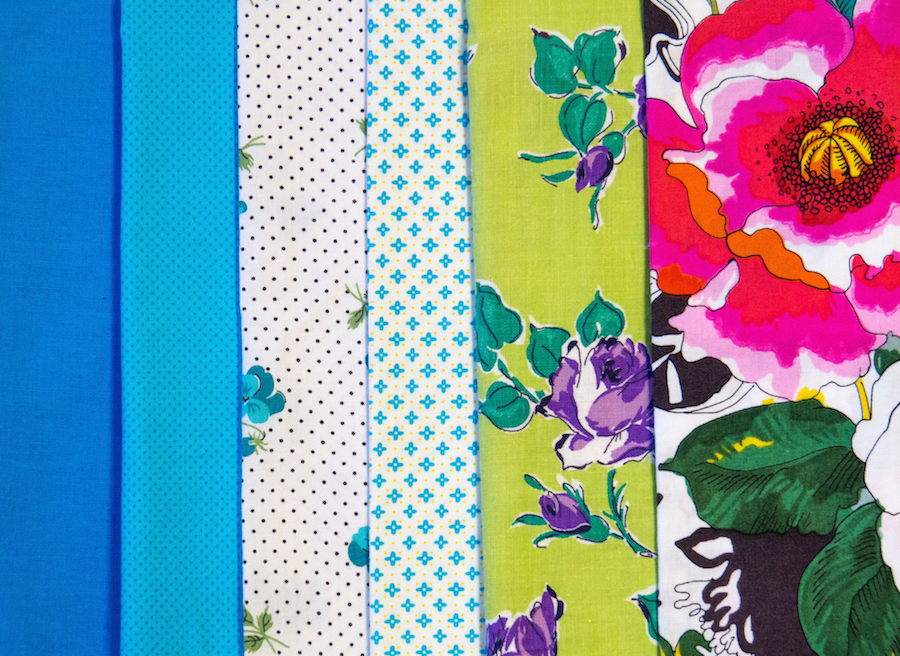
Add an even bigger print, and the relationships change.
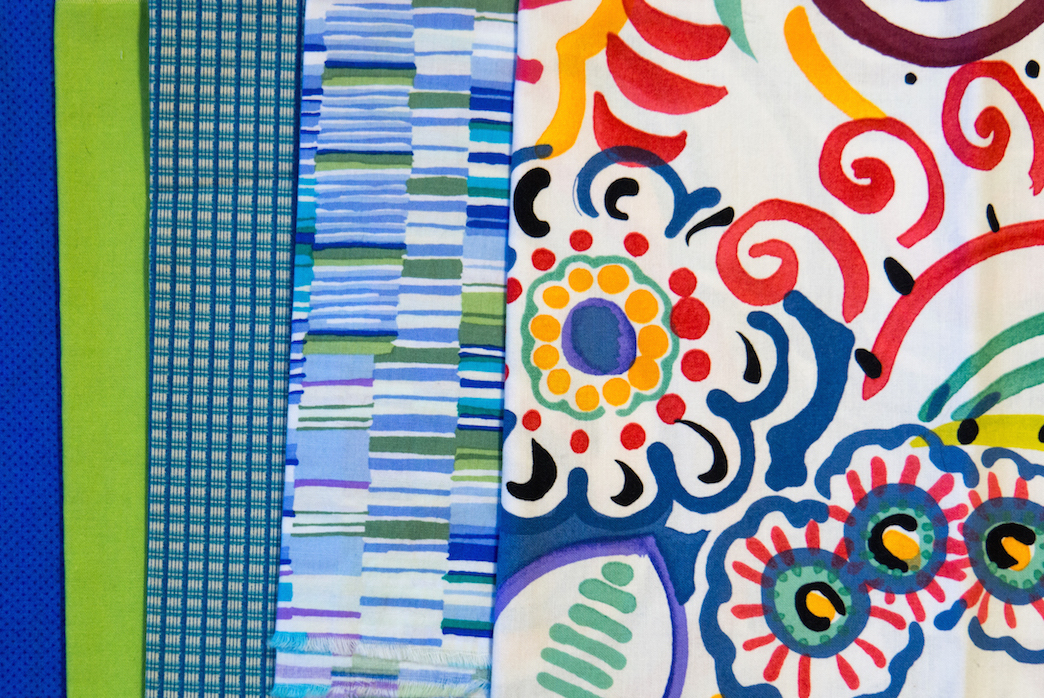
Adding prints with lines and stripes can help to visually control big and wild designs.
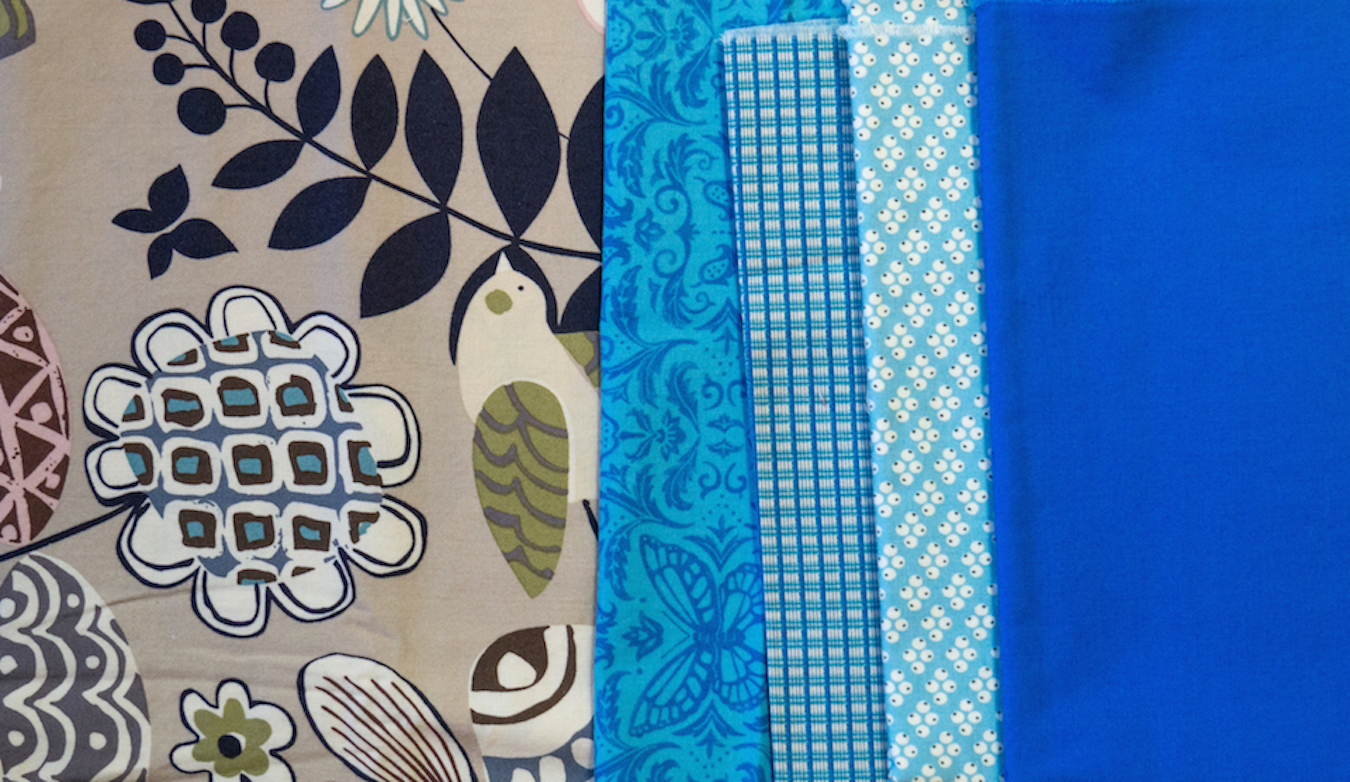
And, lastly, know that clear colors come forward and gray colors recede. So even though the big print, below, will be noticeable, the clear blues are more dominant.
Let's look at two completed quilts:
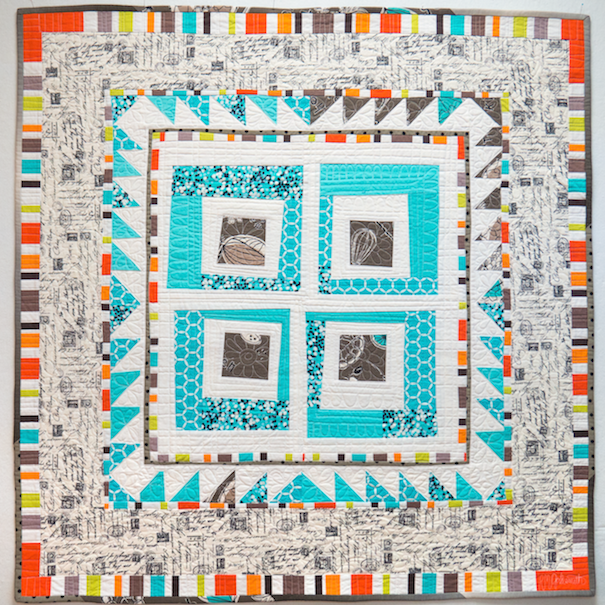
The only unpredictable fabric in this quilt is the dark gray/brown big print used in the log cabin centers and in the upper right hand triangles. You can’t see the big kitchen tools, but the shapes are cut big. I was careful to make the log cabin centers dark for continuity. I used a multi-colored stripe for the colorful inner and outer borders.

There’s a little bit of everything going on in Everyday Best. Many of the border backgrounds are cut from unpredictable fabrics that would not have cut up into consistent colors and/or values.


1. Gather a collection of fabrics together from your stash to include one as the background fabric. Your collection can be totally scrappy as in the case of Alex's quilt on the left or a more controlled color palate as Karen K. Stone's quilt Lilith on the right.
2. Using the principles you have learned today, see how dynamic a collection you can pull together by including various print scale/size, patterns, and values.
3. Using your favorite Sawtooth Star Block pattern method, make at least six different blocks. With each succesive block, try to find a way to make the next block different than the one previous.

Free Tickets Now Available for August 2017 Taping
Here's the Guest List:
You do NOT need to be a Star member to get tickets to the tapings. You do need to be a Star Member to see
all these shows and artists online.
Here are the dates, guidelines and policies for requesting tickets:
Studio Location:
WESTWORKS STUDIOS (Inside the Comcast Building)
4100 E. Dry Creek Road
Centennial, CO 80122
Dates: Friday-Tuesday, August 25-29, 2017.
Two shows are taped each day. Attending the entire day is required.
Cut-off date for requests is August 15, 2017, or when sold out.
Free tickets are offered on a first come, first served basis.
Send us an email with the words Taping Ticket in the subject line.
You will need to provide the following information in the body of the email
Full given name of each person in your group
Profile name (if existing member)
Email address
Preference of day you would like to attend
If you are requesting tickets for more than one person, you will need to provide this same information for each additional person.
All requested tickets MUST be used. Please do not request tickets if you are not committed to attending. Seating is limited to 50 and we do not overbook the seating area, so unused tickets result in empty seats, which diminishes the energy of the show and denies someone else the opportunity to attend. If you have reserved tickets that result in a "no-show" or "partial-show," you will not be eligible for tickets to future show tapings. You do not need to be a member of TQS to attend.
Tickets will be distributed for only one day of attendance. Confirmation of tickets will be in the form of an e-mail document.
To make your request for free tickets, or to get further information about tickets and our ticket policies, e-mail lilobowman.thequiltshow@gmail.com. Please note that your e-mail request for tickets should state the word TICKET in the subject line in order for it to be processed in the order it is received.
**Large groups should contact Lilo directly at (817) 367-9363.
Don't you love how Jinny uses border prints in her blocks? Find out the name of this block when you play the game.

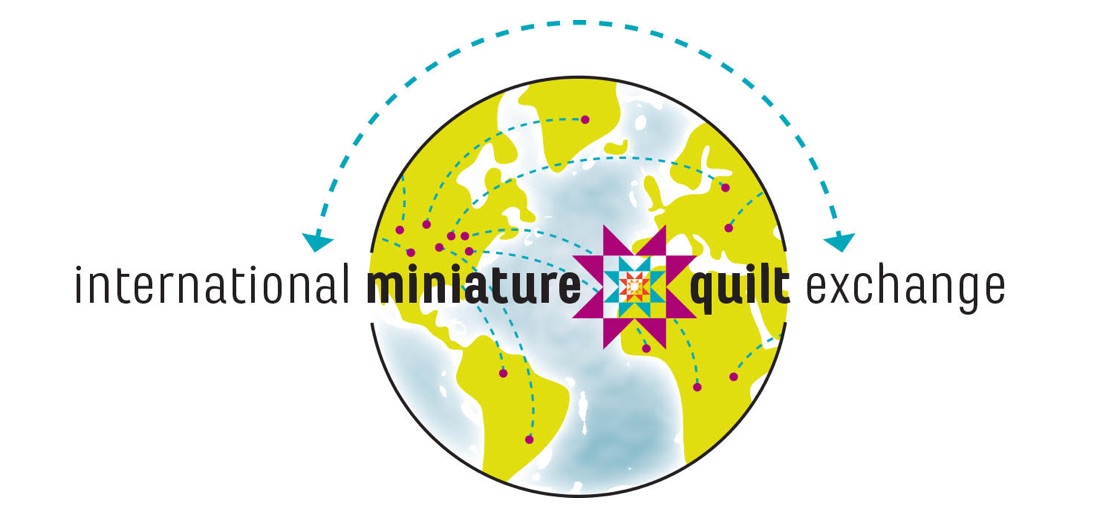
WE WANT YOU!
Join over 500 quilters in the International Miniature Quilt Exchange.
Why join an International Quilt Exchange?
According to Robert Shaw, curator of the Shelburne Museum from 1981 to 1994 and the author of QUILTS: A Living Tradition,
”The quilt has always been an art form and an artifact that binds us together at the same time that it reflects our differences...The quilt is America's art form, a medium that had already shown itself to be large and flexible enough to represent this country in all its racial, ethnic, and cultural diversity. Given the chance, it may prove large enough to represent the global village as well."
Ricky has sponsored an International Miniature Quilt Exchange for the members of TheQuiltShow.com.
The TQS International Exchange
248 United States Quilters – We still need quilters from Alaska, Hawaii, North Dakota, Rhode Island and West Virginia to get all 50 states!
25 Countries represented
Quilters have until March 2018 to complete their miniature quilts. Get all the details here.
1 International Quilter + 1 United States Quilter + A Passion for Quilting
= A Priceless Experience
Take a look at our gallery of Ricky’s miniature quilts.
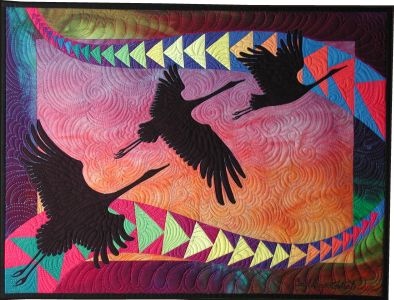 Caryl has retired from teaching but she's sharing a free lesson and pattern for this lovely "Migration" wall hanging.
Caryl has retired from teaching but she's sharing a free lesson and pattern for this lovely "Migration" wall hanging.The Women of God Know This by Lyric Kinard. Lyric writes,
Pictured are (left to right) Ruth May Marble Hoisington, Martha Acenath Hakes Marble, Nancy Lee Montgomery, Edith Ruth Hoisington Montgomery, ancestors and mothers who have come before me, from whom I have much to learn. When I struggle with the difficult task of motherhood I look to them.This quote by Neil A. Maxwell says what I feel of their work and mine. (Quote is on the quilt.) 48" x 25" - 2005
hand dyed cotton, thread, batting
dyed,discharged, fused, machine quilted

Original Photo: Mary Kay Davis